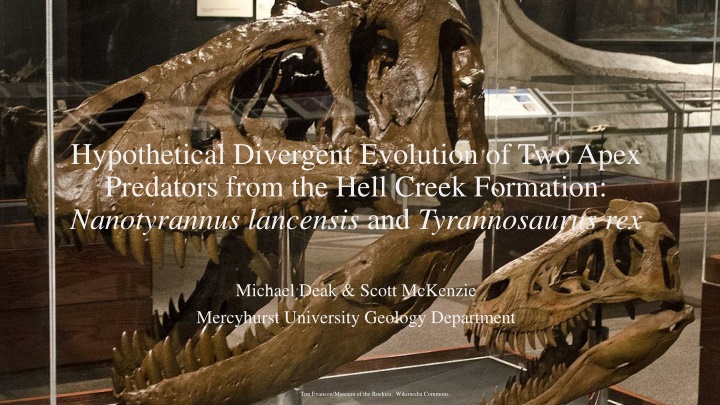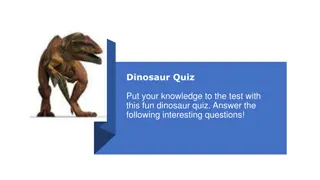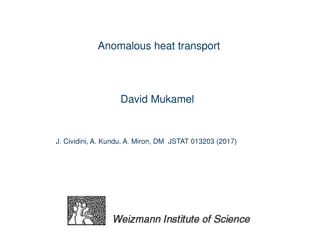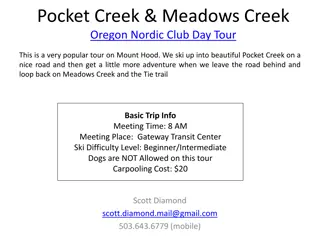Divergent Evolution of Nanotyrannus lancensis and Tyrannosaurus rex in the Hell Creek Formation
This content discusses the hypothetical divergent evolution of two apex predators, Nanotyrannus lancensis and Tyrannosaurus rex, from the Hell Creek Formation. It includes insights on their cranial osteology, tooth count, brain characteristics, and ontogeny, shedding light on their evolutionary paths and anatomical differences.
Download Presentation

Please find below an Image/Link to download the presentation.
The content on the website is provided AS IS for your information and personal use only. It may not be sold, licensed, or shared on other websites without obtaining consent from the author.If you encounter any issues during the download, it is possible that the publisher has removed the file from their server.
You are allowed to download the files provided on this website for personal or commercial use, subject to the condition that they are used lawfully. All files are the property of their respective owners.
The content on the website is provided AS IS for your information and personal use only. It may not be sold, licensed, or shared on other websites without obtaining consent from the author.
E N D
Presentation Transcript
Hypothetical Divergent Evolution of Two Apex Predators from the Hell Creek Formation: Nanotyrannus lancensis and Tyrannosaurus rex Michael Deak & Scott McKenzie Mercyhurst University Geology Department Tim Evanson/Museum of the Rockies. Wikimedia Commons.
CMNH 7541, Holotype of Nanotyrannus lancensis James St. John/Cleveland Museum of Natural History, Wikimedia Commons
BMRP 2002.4.1 (Jane) Erickson et al, 2004, Gigantism and comparative life-history parameters of tyrannosaurid dinosaurs"
Tsuihiji et. al. 2011, Cranial Osteology of a Juvenile Specimen of Tarbosaurus bataar (Theropoda, Tyrannosauridae) from the Nemegt Formation (Upper Cretaceous) of Bugin Tsav, Mongolia Left: Juvenile Tarbosaurus bataar MPC-D 107/7 Below: Cast of adult Tarbosaurus bataar from the Mercyhurst collection
Witmer et al, 2009, New Insights Into the Brain, Braincase, and Ear Region of Tyrannosaurs (Dinosauria, Theropoda), with Implications for Sensory Organization and Behavior
Despite skull crushing of some Tyrannosaurus specimens, the brain still maintains the same basic shape. Witmer et al, 2009, New Insights Into the Brain, Braincase, and Ear Region of Tyrannosaurs (Dinosauria, Theropoda), with Implications for Sensory Organization and Behavior
Range Red = T. rex Blue = N. lancensis Longrich et. al. 2012, Torosaurus Is Not Triceratops: Ontogeny in Chasmosaurine Ceratopsids as a Case Study in Dinosaur Taxonomy Tyrannosaurus rex locations after Larson (2008).
Tooth count and number of tooth placements Nanotyrannus lancensis Maxillary teeth: 15 Dentary teeth: 16-17 Tooth structure: Latteraly compressed and heavily serrated Tyrannosaurus rex Maxillary teeth: 11 Dentary teeth: 12-13 Tooth structure: Thick and minimal amount of serrations.
Possible evidence for dentary tooth reduction Horner (2011), has observed a trend in the reduction of dentary tooth positions from the smallest individuals to the largest individuals. Horner 2011, Shape- Shifting Dinosaurs: The Cause of a Premature Extinction
Stratigraphic Complications MOR 1125 (B.rex) comes from strata that is 68 million years old. BMRP 2002.4.1 has been stratigraphically aged at about 66.0-65.84 million years old by examining pollen collected from the site. (Harrison et. al. 2013). Farke et. al. 2013, Ontogeny in the tube-crested dinosaur Parasaurolophus (Hadrosauridae) and heterochrony in hadrosaurids
Size does not correlate with age and tooth count MOR 1125 was between 16-20 years, and that the age of MOR 555 was between 12-16 (Horner et. al. 2004). MOR 008 is larger than MOR 555 and has a dentary tooth count of 13. MOR 008 has a skull that is about 1.34 meters in length (approximately 4-5 feet). Geoffrey Fairchild/ Field Museum of Natural History. Wikimedia Commons
CMNH 7541 has 16 dentary tooth positions (Witmer et. al. 2010) and is a younger individual than BMRP 2002.4.1 which has 17 dentary tooth positions. Baby Bob has 12 dentary tooth positions and is about 4 years old. Witmer et. al. 2010, The Cleveland Tyrannosaur Skull (Nanotyrannus Or Tyrannosaurus): New Findings Based on CT Scanning, With Special Reference to the Braincase Robert Detrich, Pers. Comm.
Tyrannosaurus rex size vs. age and tooth count Specimen Body Length (m) Ontogenetic Age 4 years (Robert Detrich Pers. Comm.) Unknown 11-12 years Unknown 16-20 years (Horner 2004) 12-16 years (Horner 2004) 19 years 22 years 22 years Unknown 21 years Unknown 22 years 28 years Maxilary Tooth Count Dentary Tooth Count "Baby Bob" Unknown Unknown 12 CMNH 7541* BMRP 2002.4.1* "Tinker" Unknown 6.5 m 10.05 m 16 15 15 17 Unknown Unknown MOR 1125 10.54 m 12 14 MOR 555 11.8 m 12 11 12 11 13 11 11 11 12 12 13 14 12 15 13 13 13 13 BHI 3033 AMNH 5027 CM 9380 "Samson" MOR 980 LACM 23844 MOR 008 FMNH PR2081 11.9 m 12.0 m 12.04 m 12.2 m 12.3 m Unknown 12.3 m 12.3 m * = Possible specimens of Nanotyrannus lancensis
Daveynin/Carnegie Museum of Natural History, Wikimedia Commons Scott Robert Anselmo/Cleveland Museum of Natural History, Wikimedia Commons
Below: Skull of the more primitive form: Triceratops horridus (Marsh, 1889) from the AMNH Above: Cast of the skull of the more advanced form: Triceratops prorsus (Marsh, 1890) from the Mercyhurst collection Janie and Jim Eden/American Museum of Natural History, Wikimedia Commons
Why get small in a world of giants? Resource partitioning to maintain punctuated equilibrium Ex 1: North American canids and African felids evolved various sizes to exploit various prey Gunnar Ries , Wikimedia Commons.. Christopher Bruno, Wikimedia Commons. Bengt Nyman, Wikimedia Commons. Public Domain Images. P. Lindgren, Wikimedia Commons. James Temple, Wikimedia Commons.
Jos Maria Silveira Neto, Wikimedia Commons Venture Vancouver, Wikimedia Commons Ex. 2: Late Jurassic Theropods also went down a similar evolutionary pathway.
Possible role in Late Cretaceous ecosystem Large Orbitals Accounts for 15.4% of total skull length (Chure, 1998). Juvenile character? Indication of nocturnal behavior? Mimicry? Ballista/Museum of Natural History, London. Wikimedia Commons
Conclusions Previous examinations of the skull of CMNH 7541 and of the histology of BMRP 2002.4.1 have shown that these two specimens of Nanotyrannus are still growing at a rapid pace. The possibility that they represent juveniles of Tyrannosaurus rex is still plausible. It is not clear if Nanotyrannus inhabited all of the localities and strata where Tyrannosaurus has been known to inhabit. It is highly unlikely that Tyrannosaurus lost tooth positions throughout ontogeny due to: Some intermediates being stratigraphically inconsistent Individual variation of dental alveoli If Nanotyrannus is a valid species, and if it diverged from Tyrannosaurus, then it shows that the dinosaurs are still diversifying in the Late Cretaceous.
Acknowledgments Peter L. Larson Black Hills Institute of Geological Research Inc., Hill City, SD, United States Dr. Thomas R. Holtz Jr. University of Maryland, College Park, MD, United States Scott A. Williams Burpee Museum of Natural History, Rockford, IL, United States Dr. Philip J. Currie Royal Tyrrell Museum of Paleontology, Drumheller, AB, Canada Robert J. Detrich Detrich Fossil Company, Robert@fossilking.net Dr. John B. Scannella Museum of the Rockies, Bozeman, MT, United States Disclaimer: Although all these people aided us in this investigation, they may not agree with our conclusions. However, the help of these specialists is greatly appreciated.
Sources Carr, T. D. (1999). Craniofacial ontogeny in tyrannosauridae (Dinosauria, Coelurosauria). Journal of vertebrate Paleontology, 19(3), 497-520. Carr, T. D., & Williamson, T. E. (2004). Diversity of late Maastrichtian Tyrannosauridae (Dinosauria: Theropoda) from western North America. Zoological Journal of the Linnean Society, 142(4), 479-523. Chure, D. J. (2000). On the orbit of theropod dinosaurs. Gaia, 15, 233-240. Currie, P. J., Hurum, J. H., & Sabath, K. (2003). Skull structure and evolution in tyrannosaurid dinosaurs. Acta Palaeontologica Polonica, 48(2), 227-234. Dodson, P. (1975). Taxonomic implications of relative growth in lambeosaurine hadrosaurs. Systematic Biology, 24(1), 37-54. Erickson, G. M., Makovicky, P. J., Currie, P. J., Norell, M. A., Yerby, S. A., & Brochu, C. A. (2004). Gigantism and comparative life-history parameters of tyrannosaurid dinosaurs. Nature, 430(7001), 772-775. Farke, A. A., Chok, D. J., Herrero, A., Scolieri, B., & Werning, S. (2013). Ontogeny in the tube-crested dinosaur Parasaurolophus (Hadrosauridae) and heterochrony in hadrosaurids. PeerJ, 1, e182.. Harrison, W. F., Nichols, D. J., Henderson, M. D., Scherer, R. P (2013). Using Pollen, Leaves, and Paleomagnetism to Date a Juvenile Tyrannosaurid in Upper Cretaceous Rock. Tyrannosaurid Paleobiology (239-249). Horner, J. R., & Padian, K. (2004). Age and growth dynamics of Tyrannosaurus rex. Proceedings of the Royal Society of London B: Biological Sciences, 271(1551), 1875-1880. Larson, P. L. (2008). Variation and sexual dimorphism in Tyrannosaurus rex. Tyrannosaurus rex, 103-130. Larson, P. (2013). The case for Nanotyrannus. Tyrannosaurid Paleobiology, 15-53. Longrich, N. R., & Field, D. J. (2012). Torosaurus is not Triceratops: ontogeny in chasmosaurine ceratopsids as a case study in dinosaur taxonomy. PloS one, 7(2), e32623. TED. (2011, November). Jack Horner: Where are the baby dinosaurs? [Video file]. Retrieved from http://www.ted.com/talks/jack_horner_shape_shifting_dinosaurs?language=en Tsuihiji, T., Watabe, M., Tsogtbaatar, K., Tsubamoto, T., Barsbold, R., Suzuki, S., ... & Witmer, L. M. (2011). Cranial osteology of a juvenile specimen of Tarbosaurus bataar (Theropoda, Tyrannosauridae) from the Nemegt Formation (Upper Cretaceous) of Bugin Tsav, Mongolia. Journal of Vertebrate Paleontology, 31(3), 497-517. Witmer, L. M., & Ridgely, R. C. (2009). New insights into the brain, braincase, and ear region of tyrannosaurs (Dinosauria, Theropoda), with implications for sensory organization and behavior. The Anatomical Record, 292(9), 1266-1296. Witmer, L. M., & Ridgely, R. C. (2010). The Cleveland tyrannosaur skull (Nanotyrannus or Tyrannosaurus): new findings based on CT scanning, with special reference to the braincase. Kirtlandia, 57, 61-81.























